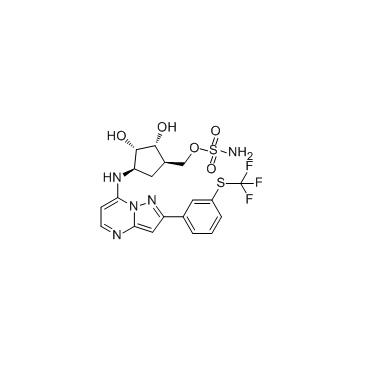TAK-243 (MLN7243) (Synonyms: TAK-243) |
| Catalog No.GC32737 |
TAK-243 (MLN7243) (MLN7243) is a first-in-class, selective ubiquitin activating enzyme, UAE (UBA1) inhibitor (IC50=1 nM), which blocks ubiquitin conjugation, disrupting monoubiquitin signaling as well as global protein ubiquitination. TAK-243 (MLN7243) (MLN7243) induces endoplasmic reticulum (ER) stress, abrogates NF-κB pathway activation and promotes apoptosis.
Products are for research use only. Not for human use. We do not sell to patients.

Cas No.: 1450833-55-2
Sample solution is provided at 25 µL, 10mM.
TAK-243 is a potent and selective ubiquitin-like modifier activating enzyme 1 (UBA1) inhibitor.
TAK-243 (MLN7243) selectively kills a subset of cutaneous squamous cell carcinoma (cSCC) lines. squamous cell carcinoma transplant (SCCT) and SCCRDEBMet cells are the most susceptible to continuous treatment with TAK-243. SCCIC1Met cells are also selectively killed by an extended exposure to TAK-243. Death in SCCRDEBMet cells displays the greatest sensitivity to a pulse of TAK-243. MLN7243 can reduce the cellular level of ubiquitin conjugates. TAK-243 decreases UBA1 and UBA6 thioesters and thioesters of the UBA6 specific E2 UBE2Z/USE1[1]. TAK-243 displays preferential activity towards acute myeloid leukemia (AML) cells over normal hematopoietic cells. TAK-243 reduces growth and viability of human AML cell lines (OCI-AML2, TEX, U937 and NB4) in a concentration- and time-dependent manner with IC50 's ranging from 15-40 nM after treatment for 48 hours[2].
TAK-243 significantly delays tumor growth in mice (T/C=0.02) with no toxicity as evidenced by no changes in mouse body weight, serum chemistry, or organ histology. TAK-243 reduces primary AML tumor burden in both tested samples without toxicity[2].
[1]. McHugh A, et al. Preclinical comparison of proteasome and ubiquitin E1 enzyme inhibitors in cutaneous squamous cell carcinoma: the identification of mechanisms of differential sensitivity. Oncotarget. 2018 Apr 17;9(29):20265-20281. [2]. Samir H. Barghout, et al. TAK-243 Is a Selective UBA1 Inhibitor That Displays Preclinical Activity in Acute Myeloid Leukemia (AML). Blood 2017, 130:814.
Average Rating: 5 (Based on Reviews and 2 reference(s) in Google Scholar.)
GLPBIO products are for RESEARCH USE ONLY. Please make sure your review or question is research based.
Required fields are marked with *




















